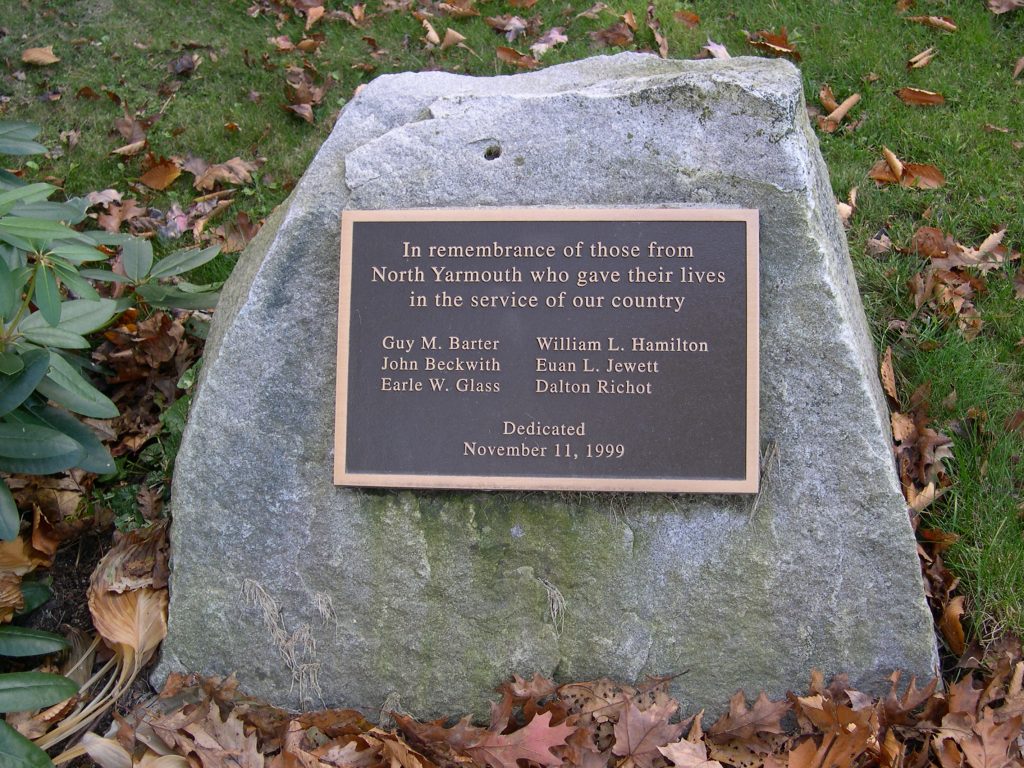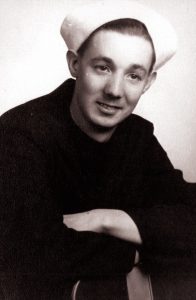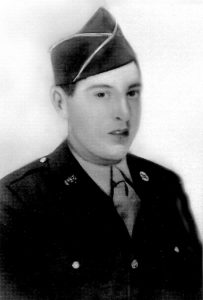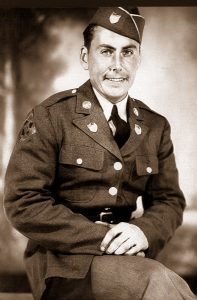
On this Memorial Day weekend, we honor all who have served our country in the US military. Several servicemen are honored at Veterans Memorial Park in North Yarmouth; their stories are featured here. Take a moment to read about the six who served in WWII and made the ultimate sacrifice. Together with their families, we remember.
 Guy Millard Barter, son of Myra and Roy Barter, was born March 21, 1919. He graduated from North Yarmouth Academy in 1936 with honors. Guy was active as Lecturer in the Wescustogo Grange and was North Yarmouth Congregational Church’s assistant superintendent. He worked on the town roads, and in 1940 was a US Census taker in Cumberland. A popular and energetic young man, he was saving money for college, where he planned to study engineering.
Guy Millard Barter, son of Myra and Roy Barter, was born March 21, 1919. He graduated from North Yarmouth Academy in 1936 with honors. Guy was active as Lecturer in the Wescustogo Grange and was North Yarmouth Congregational Church’s assistant superintendent. He worked on the town roads, and in 1940 was a US Census taker in Cumberland. A popular and energetic young man, he was saving money for college, where he planned to study engineering.
In the spring of 1941, he enlisted in the US Army and was sent to the South Pacific. Along with a medic in his battalion, the 43rd, he prayed every day and read the 91st Psalm (“Who dwells in the shelter of the Most High will rest in the shadow of the Almighty...”) On January 15, 1945, Guy was the staff sergeant in charge of an antitank gun emplacement in Luzon, Philippines, when Japanese troops attacked. During fierce fighting that lasted through the night, he was wounded in hand-to-hand combat.
His medic friend treated Guy’s wounds and, knowing the end was near, prayed with him, reading a scripture that their chaplain had given Guy just a few weeks before. The verses were written on a piece of paper inside an empty walnut shell and contained 1Timothy 2:12: “If we suffer we also shall reign with him.” Two hours after he was wounded, Guy died in hospital. He is buried at Walnut Hill Cemetery.
 John Beckwith, son of Natalie and Merle Beckwith, was born in 1923. He attended North Yarmouth Academy, where he played baseball. He was working for the Portland Company when war was declared and he enlisted, along with several of his friends. He served in the Merchant Marines, working as an “oiler” on a convoy of ships delivering materials to Europe.
John Beckwith, son of Natalie and Merle Beckwith, was born in 1923. He attended North Yarmouth Academy, where he played baseball. He was working for the Portland Company when war was declared and he enlisted, along with several of his friends. He served in the Merchant Marines, working as an “oiler” on a convoy of ships delivering materials to Europe.
John had been away for six months when, in the fall of 1943, his ship came into port in Boston for repairs. He was given leave to come home to Maine—but his leave was canceled early after a visit of only three or four days. Before he left, John gave money to his brother Marvin for Christmas presents for Marvin’s children, saying he did not think he would be home for the holidays.
He then hurried back to Boston, but his ship had already sailed, so he was assigned to another, the SS Nevada.
The Nevada was built in 1915 and was not capable of handling the rough North Atlantic Seas. On December 16, 1943 in a raging gale and heavy seas, the ship began sinking off Cape Farwell, Greenland. It was abandoned. John boarded a lifeboat with half the Nevada‘s crew of 64 men.
As the lifeboat was being lowered into the ocean, a wave swept the deck of the ship and knocked over the crew letting down the boat. It fell into the ocean and all the men aboard were thrown into the sea and lost. John’s body was never recovered.
 Earle W. Glass, Jr. was born March 9, 1925, the son of Ethel and Earle Glass. He had moved to Gray and North Yarmouth from Vermont with his family when he was a young boy. He was a popular student at Pennell Institute in Gray, where he excelled as a member of the track team. On weekends and vacations he worked as a mechanic at the General Ice Cream Company (Sealtest) in Portland where his father also worked. Earle, “Teeny,” sang in his family’s band. Drafted into the Army while in high school, he married Georgia Bean, and left for basic training.
Earle W. Glass, Jr. was born March 9, 1925, the son of Ethel and Earle Glass. He had moved to Gray and North Yarmouth from Vermont with his family when he was a young boy. He was a popular student at Pennell Institute in Gray, where he excelled as a member of the track team. On weekends and vacations he worked as a mechanic at the General Ice Cream Company (Sealtest) in Portland where his father also worked. Earle, “Teeny,” sang in his family’s band. Drafted into the Army while in high school, he married Georgia Bean, and left for basic training.
Earle was given leave to come home when Georgia gave birth to their daughter Carolyn. He was then shipped directly to Africa where he served in the motor pool. At one point he was given a day of leave and spent it with his brother Robert who worked in a different motor pool. Within two weeks, Earle was on a troop carrier on his way to Italy and the bloody invasion at Anzio.
He was killed in action on February 9, 1944 at age of 18. Carolyn says the family was told he was on a fuel truck that was attacked by the Germans; he died later in a hospital from his wounds. He was buried in Italy but several years later his mother had his body brought back and buried at Forest Cemetery in South Portland. She never accepted that he had died in the war and felt at some point he would come home again.
 William Laforest Hamilton, son of Meda and William Hamilton, was born October 16, 1912. He attended Greely Institute as a freshman, then left school to work as a laborer in a sawmill.
William Laforest Hamilton, son of Meda and William Hamilton, was born October 16, 1912. He attended Greely Institute as a freshman, then left school to work as a laborer in a sawmill.
Bill was drafted into the Army’s 78th Division and held the rank of Sergeant. He was killed in action in the province of Ascoli Piceno in the Marche region of Italy on April 21, 1945. Sadly, it was only one day after seeing his sister Vyra Hamilton Tompson’s brother-in-law Albert Tompson, who was also serving in Italy in the Army. Albert had sought out Bill out to say hello.
Bill’s body was returned for burial in Walnut Hill Cemetery; Rev. Gladys York conducted the funeral service. His mother Meda used the money she received upon Bill’s death to put a foundation under her home at 601 Walnut Hill Road.
After death, Bill was awarded a Purple Heart.
 Euan Lochel Jewett was born on September 13, 1913, the son of Laura and Ralph Jewett. He was one of six brothers who served in different branches of the military during WWII and was the family’s only casualty. Euan graduated from 8th grade at the Hicks School on the corner of New Gloucester Road (Route 231) and Mill Road. He worked many jobs including as a farmhand and a mason’s helper. He was very strong; when townspeople gathered at a large rock at the Jewett farm to see who was strong enough to pick it up, Euan was one of the few who were able to lift it.
Euan Lochel Jewett was born on September 13, 1913, the son of Laura and Ralph Jewett. He was one of six brothers who served in different branches of the military during WWII and was the family’s only casualty. Euan graduated from 8th grade at the Hicks School on the corner of New Gloucester Road (Route 231) and Mill Road. He worked many jobs including as a farmhand and a mason’s helper. He was very strong; when townspeople gathered at a large rock at the Jewett farm to see who was strong enough to pick it up, Euan was one of the few who were able to lift it.
He was in the process of buying the George Rider farm on Town Farm Road when he was drafted into the Navy. He served as a Seaman, Second Class on the SS Ruth, a merchant marine freighter hauling manganese ore from Rio de Janeiro, Brazil, to Charleston, South Carolina. It was Euan’s first voyage. He was one of the ship’s two armed guards, although it is not known if there were guns mounted on the ship; one wonders what good two men could do in the event of an attack.
On June 29, 1942, 100 miles north of Cape Maysi, Cuba, the Ruth was torpedoed by the German submarine U-153 Reichmann and sunk; there were 31 casualties and four survivors. His body was never recovered. A marker on his father’s grave in Walnut Hill Cemetery commemorates his life. Euan was the first North Yarmouth casualty of the war.
 Harry Dalton Ritchot was born in Portland on May 19, 1914 to Isabelle and George Ritchot. He graduated from high school in Montreal, where his father had been transferred in his job with the Grand Trunk Railroad.
Harry Dalton Ritchot was born in Portland on May 19, 1914 to Isabelle and George Ritchot. He graduated from high school in Montreal, where his father had been transferred in his job with the Grand Trunk Railroad.
His family called him Dalton, to distinguish him from his Uncle Harry. In 1936, Dalton moved to North Yarmouth and worked as a farm laborer. When George Ritchot retired, he and Isabelle joined Dalton in renting the current Skyline Farm on The Lane in 1938.
In 1941 Dalton enlisted in the Army, training at various bases with the Fourth Division. His letters home indicated his feelings of patriotism and his desire to get over to the action. In the spring of 1944, Sergeant Ritchot was shipped by boat to Europe; he proudly wrote that he did not get seasick. On D-Day, Dalton took Utah Beach along with his fellow soldiers of the Fourth Division. On June 19, 1944, five days after earning a Bronze Star for his bravery during battle, Dalton was killed in action. Upon hearing the news of his youngest child’s sacrifice, George Ritchot suffered a stroke and was unable to speak. He died a few months later after insisting that his son be brought back to the family plot to be buried. Dalton is buried in Calvary Cemetery in South Portland.
… … …
Stories of our veterans need to be told. If you would like the story of your family member to be part of North Yarmouth Historical’s archives, please get in touch. We’d like to be sure they are all remembered!
All the best on this Memorial Day.
Original research published in the North Yarmouth Gazette, 2004, by Linc Merrill. Additional info added 2023 by Katie Murphy